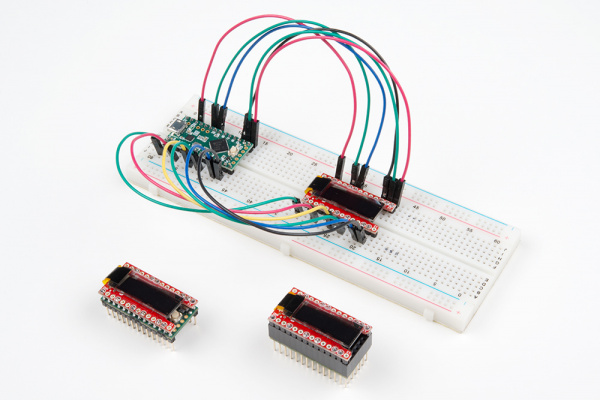TeensyView Hookup Guide
Contributors:
 MTaylor
MTaylor
Resources and Going Further
The TeensyView was designed to be as flexible as possible while still being able to nest down into a low-profile addition to the Teensy.
Some various TeensyView-Teensy connections. The bottom centermost TeensyView was created using this guide, while the left is a minimal non-separable configuration. Using a breadboard is also an option.
The TeensyView works with some really heavy examples, but they're really only demonstrations. What to do with it is up to you! They're great for adding simple debug info to a mobile project, while a diligent pixel artist could implement a whole menu system.
More information about the SSD1306 controller and the TeensyView design can be found here:
- Product GitHub Repository
- Library GitHub Repository
- Drawing Bitmaps --- How to make a bitmap array
- OLED Memory Map --- Talks about screen geometry and making fonts
Additional projects and sketches that use the TeensyView:
- The HighSpeedTest, in the examples folder, draws alternating pixels as fast as possible. This can be used to experiment with the limits of the TeensyView's OLED.
For additional inspiration, check out these other tutorials based on displays:
Micro OLED Breakout Hookup Guide
Learn how to hook up the Micro OLED breakout to an Arduino. Then draw pixels, shapes, text and bitmaps all over it!
Alphanumeric GPS Wall Clock
This is a GPS controlled clock - a clock you truly never have to set! Using GPS and some formulas, we figure out what day of the week and if we are in or out of daylight savings time.
Beginner Parts Kit Identification Guide
The essential parts for beginning (or even experienced) hobbyists that gives you all of the basic through-hole components you will need to get started playing with embedded projects. We'll identify a few parts in the kit and provide a few basic circuits to get started!
MicroMod Qwiic Pro Kit Project Guide
The MicroMod Qwiic Pro Kit was designed to allow users to get started with Arduino without the need for soldering or a breadboard. We've included three inputs (a joystick, accelerometer, and proximity sensor) and one display that can be daisy chained to the MicroMod SAMD51 Processor Board.
